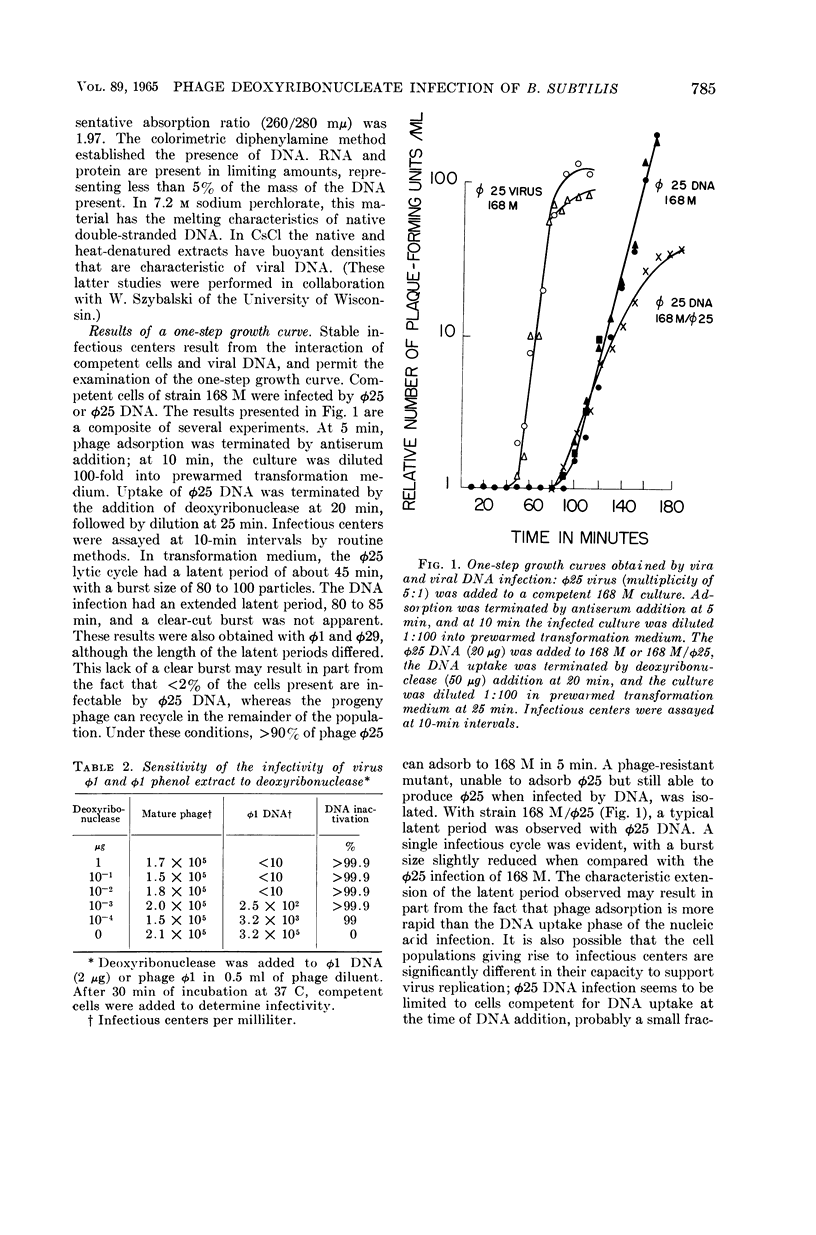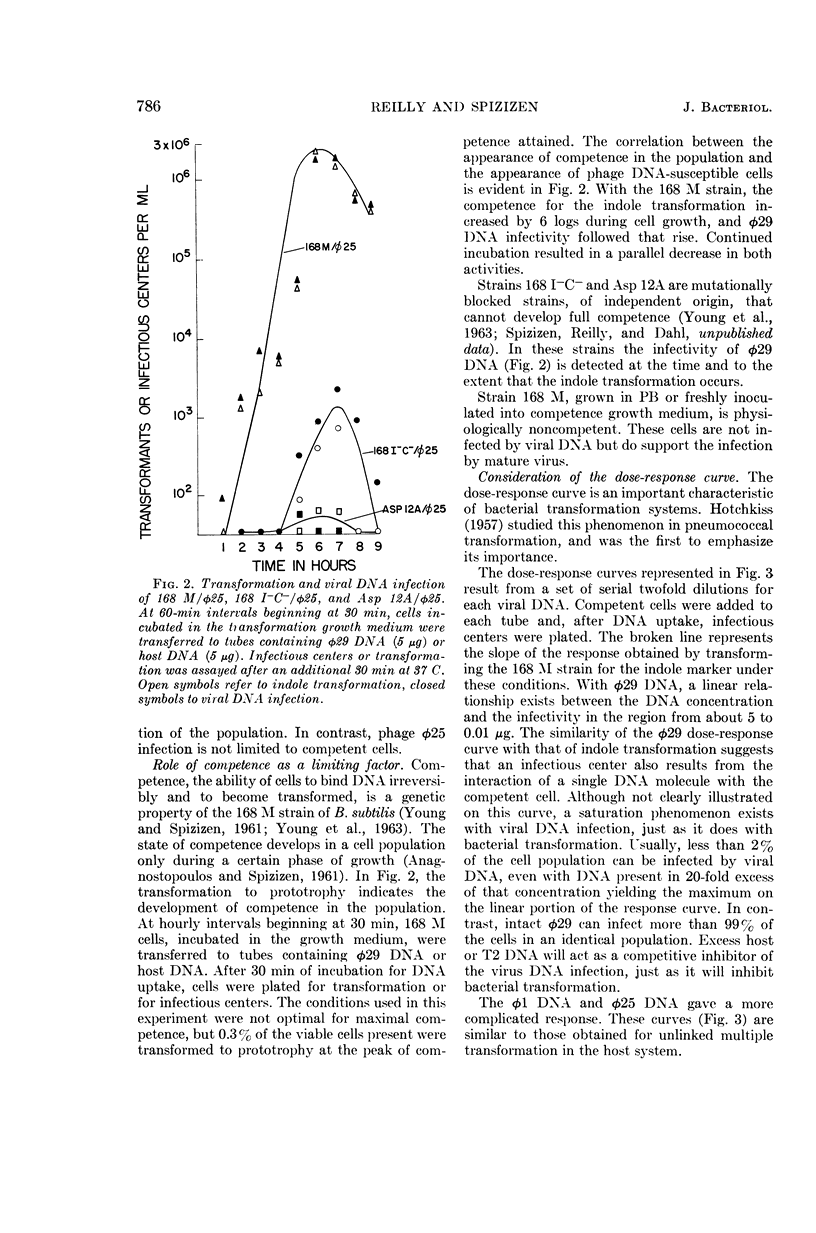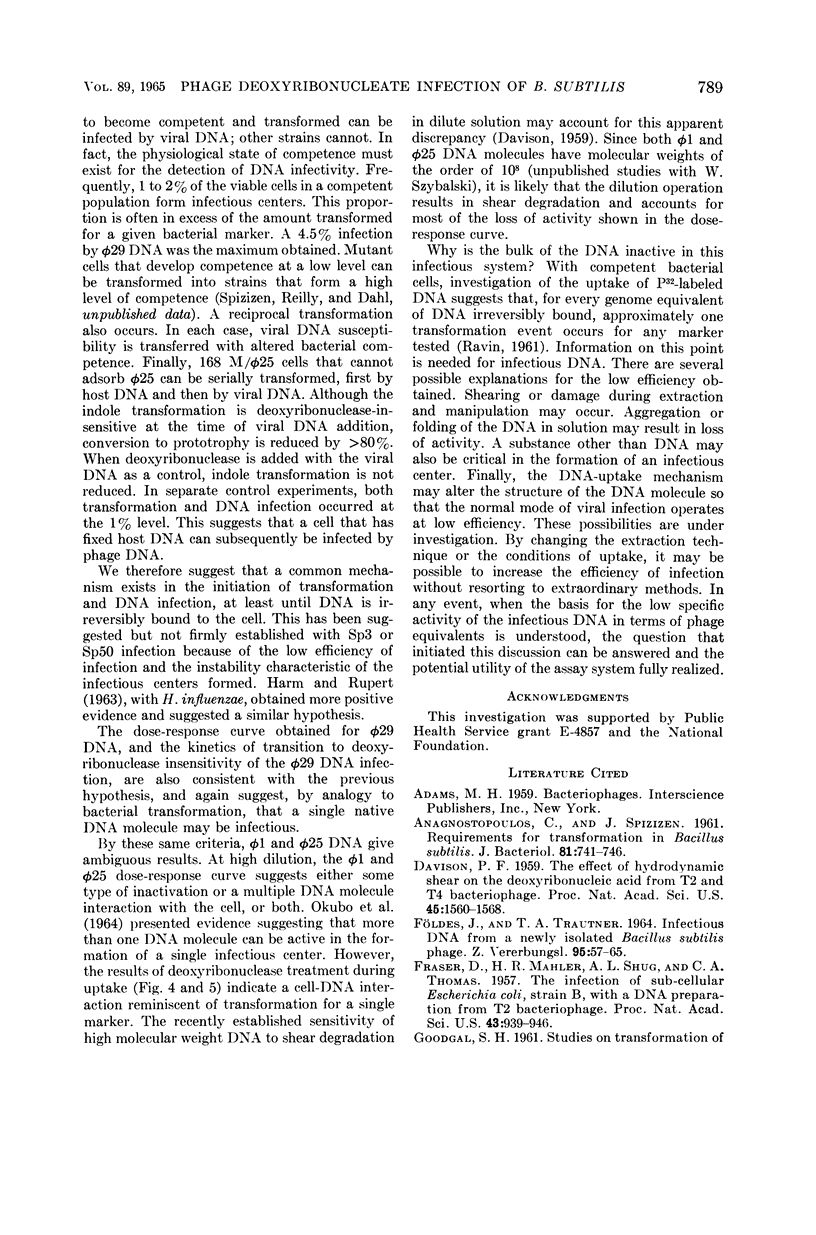Abstract
Reilly, Bernard E. (Western Reserve University, Cleveland, Ohio), and John Spizizen. Bacteriophage deoxyribonucleate infection of competent Bacillus subtilis. J. Bacteriol. 89:782–790. 1964.—Phenol extracts of the Bacillus subtilis bacteriophages φ1, φ25, and φ29 contained infectious deoxyribonucleic acid. The infectivity was destroyed by catalytic amounts of deoxyribonuclease but not by specific phage antiserum, ribonuclease, or trypsin. An infectivity of >106 infectious centers formed per μg of deoxyribonucleic acid (DNA) added was obtained. The stability of the infectious centers permitted an examination of a single cycle of phage replication in cells unable to adsorb the mature virus. A typical cycle was observed, although the latent period was increased and the burst size slightly reduced after DNA infection. The development of competence for bacterial transformation was strongly correlated with susceptibility to viral DNA infection. Both appeared and disappeared at the same phase of growth in the cell population. More than 4% of the viable cells in the competent population were infected by viral DNA. The kinetics of the transition of φ29 DNA infection to deoxyribonuclease insensitivity, and the relationship of infectivity to DNA dilution, were similar to the results obtained for bacterial transformation of a single marker. The doseresponse curve of φ1 and φ25 DNA was characteristic of that obtained in multiple transformation of unlinked genetic markers. Because of the low efficiency of infection, about 10−4 per phage equivalent of DNA added, it was not possible to prove that DNA alone was sufficient to initiate infection.
Full text
PDF








Selected References
These references are in PubMed. This may not be the complete list of references from this article.
- Anagnostopoulos C., Spizizen J. REQUIREMENTS FOR TRANSFORMATION IN BACILLUS SUBTILIS. J Bacteriol. 1961 May;81(5):741–746. doi: 10.1128/jb.81.5.741-746.1961. [DOI] [PMC free article] [PubMed] [Google Scholar]
- Davison P. F. THE EFFECT OF HYDRODYNAMIC SHEAR ON THE DEOXYRIBONUCLEIC ACID FROM T(2) AND T(4) BACTERIOPHAGES. Proc Natl Acad Sci U S A. 1959 Nov;45(11):1560–1568. doi: 10.1073/pnas.45.11.1560. [DOI] [PMC free article] [PubMed] [Google Scholar]
- FOELDES J., TRAUTNER T. A. INFECTIOUS DNA FROM A NEWLY ISOLATED B. SUBTILIS PHAGE. Z Vererbungsl. 1964 Apr 10;95:57–65. doi: 10.1007/BF00898184. [DOI] [PubMed] [Google Scholar]
- Fraser D., Mahler H. R., Shug A. L., Thomas C. A. THE INFECTION OF SUB-CELLULAR ESCHERICHIA COLI, STRAIN B, WITH A DNA PREPARATION FROM T2 BACTERIOPHAGE. Proc Natl Acad Sci U S A. 1957 Nov 15;43(11):939–947. doi: 10.1073/pnas.43.11.939. [DOI] [PMC free article] [PubMed] [Google Scholar]
- GOODGAL S. H. Studies on transformations of Hemophilus influenzae. IV. Linked and unlinked transformations. J Gen Physiol. 1961 Nov;45:205–228. doi: 10.1085/jgp.45.2.205. [DOI] [PMC free article] [PubMed] [Google Scholar]
- HARM W., RUPERT C. S. INFECTION OF TRANSFORMABLE CELLS OF HAEMOPHILUS INFLUENZAE BY BACTERIOPHAGE AND BACTERIOPHAGE DNA. Z Vererbungsl. 1963 Dec 30;94:336–348. doi: 10.1007/BF00897593. [DOI] [PubMed] [Google Scholar]
- HERSHEY A. D., CHASE M. Independent functions of viral protein and nucleic acid in growth of bacteriophage. J Gen Physiol. 1952 May;36(1):39–56. doi: 10.1085/jgp.36.1.39. [DOI] [PMC free article] [PubMed] [Google Scholar]
- KAISER A. D., HOGNESS D. S. The transformation of Escherichia coli with deoxyribonucleic acid isolated from bacteriophage lambda-dg. J Mol Biol. 1960 Dec;2:392–415. doi: 10.1016/s0022-2836(60)80050-2. [DOI] [PubMed] [Google Scholar]
- KAISER A. D. The production of phage chromosome fragments and their capacity for genetic transfer. J Mol Biol. 1962 Apr;4:275–287. doi: 10.1016/s0022-2836(62)80005-9. [DOI] [PubMed] [Google Scholar]
- MANDELL J. D., HERSHEY A. D. A fractionating column for analysis of nucleic acids. Anal Biochem. 1960 Jun;1:66–77. doi: 10.1016/0003-2697(60)90020-8. [DOI] [PubMed] [Google Scholar]
- ROMIG W. R. Infection of Bacillus subtilis with phenol-extracted bacteriophages. Virology. 1962 Apr;16:452–459. doi: 10.1016/0042-6822(62)90226-x. [DOI] [PubMed] [Google Scholar]
- Spizizen J. INFECTION OF PROTOPLASTS BY DISRUPTED T2 VIRUS. Proc Natl Acad Sci U S A. 1957 Aug 15;43(8):694–701. doi: 10.1073/pnas.43.8.694. [DOI] [PMC free article] [PubMed] [Google Scholar]
- Spizizen J. TRANSFORMATION OF BIOCHEMICALLY DEFICIENT STRAINS OF BACILLUS SUBTILIS BY DEOXYRIBONUCLEATE. Proc Natl Acad Sci U S A. 1958 Oct 15;44(10):1072–1078. doi: 10.1073/pnas.44.10.1072. [DOI] [PMC free article] [PubMed] [Google Scholar]
- YOUNG F. E., SPIZIZEN J., CRAWFORD I. P. BIOCHEMICAL ASPECTS OF COMPETENCE IN THE BACILLUS SUBTILIS TRANSFORMATION SYSTEM. I. CHEMICAL COMPOSITION OF CELL WALLS. J Biol Chem. 1963 Sep;238:3119–3125. [PubMed] [Google Scholar]
- YOUNG F. E., SPIZIZEN J. Physiological and genetic factors affecting transformation of Bacillus subtilis. J Bacteriol. 1961 May;81:823–829. doi: 10.1128/jb.81.5.823-829.1961. [DOI] [PMC free article] [PubMed] [Google Scholar]


